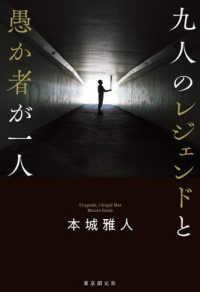- ホーム
- > 洋書
- > 英文書
- > Cinema / Film
Full Description
A metaphysics of film for a post-metaphysical age
Stages a dialogue between film and philosophy on the question of metaphysics
Theorizes the workings of a metaphysical film style" and analyses its varied characteristics through close readings of films
Situates the moving image in the context of the visual arts (i.e., photography and painting) as part of the history of aesthetic disclosure
Speculates on the value of a return of metaphysics for a post-metaphysical age
Metaphysics and the Moving Image is an investigation into the medium of film's inheritance of metaphysics Western philosophy's oldest and most ambitious form of 'truth-seeking.' Why does the moving image of film take up this ancient quest at the very moment when philosophy sought to abandon it once and for all? As the long age of metaphysics comes to a close with the Nietzschean 'death of God' and its crisis of nihilism, the emergence of film at the dawn of a new century brings forth a new absolute value, both life-affirming and more-than-human: 'the world in its own image.' Film radically transforms the metaphysical paradigm from rational speculation through concepts to mechanical revelation through images and sounds the 'dream machine' at the heart of the medium's capacity to enlighten and enthrall.
In this book, Trevor Mowchun discusses film theorists and philosophers such as Martin Heidegger, Stanley Cavell, Robert Bresson, and Heinrich von Kleist, in relation to films which possess a 'metaphysical film style,' including The Thin Red Line and The Turin Horse. Painting and photography are also considered a precursor to the moving image, but it's a specifically cinematic metaphysics which promises to lead us out of the traps of abstraction and alienation inadvertently set by old metaphysics. Mowchun demonstrates that in a post-metaphysical world, questions about being, value, truth, life and death return with renewed force, finding concrete yet open-ended responses in cinema.
"
Contents
Introduction: The Death of God, the Birth of Film, and the New Metaphysics
Chapter One Image Breakthrough: Disclosure and Derailment in Painting, Photography, and Film
I. Art in the Wake of Metaphysics
II. The Myth of the Lumière Leaf
Chapter Two The Evolution of the Concept of "World" from Philosophy to Film
I. The World in the Palm of Philosophy
II. Film in the World's Palm, or the World in its Own Image
III. Metaphysical Figures in Days of Heaven
Chapter Three Paradise Exposed: Psychic Automatism in Film
Primer: "While the will is off its watch"
I. The Mechanical Garden
II. Heinrich von Kleist's Marionette Theater
III. Robert Bresson's Filmic Models
Chapter Four Nature, Whose Death Shines a Light: Exteriority and Overexposure in The Thin Red Line
I. Introduction
II. Dramaturgy of Nature
III. A Cinematic Sublime
IV. Metaphysics of the Front
Chapter Five "Mother, I am Dumb ...": The Reevaluation of Friedrich Nietzsche in The Turin Horse








